[NOTE: November 1, 2016. This post has been updated based on the new things I’ve learned about these images since posting the original article.]
I was doing some work for a colleague at the Family Leadership Design Collaborative, and she gave me a challenge: redesign the “equity vs. equality” graphic that’s been circulating on the web. You’ve probably come across a version of this graphic yourself. There are a bunch of iterations, but basically it shows three people trying to watch a baseball game over the top of a fence. The people are different heights, so the shorter ones have a harder time seeing. I’ve included the original image above, by Craig Froehle.
In the first of two images, all three people have one crate to stand on. In other words, there is “equality,” because everyone has the same number of crates. While this is helpful for the middle-height person, it is not enough for the shortest and superfluous for the tallest. In contrast, in the second image there is “equity” — each person has the number of crates they need to fully enjoy the game.
The distinction between equity and equality is an important one. For example, if we’re talking about school funding, advocating for equality would mean ensuring that all schools had the same amount of resources per pupil (an improvement in most cases, to be sure). On the other hand, advocating for equity would mean recognizing that some schools — like those serving students in low-income Communities of Color — will actually need more resources (funding, experienced teachers, relevant curriculum, etc.) if we are going to make a dent in the educational disparities that have come to be known as the “achievement gap.”
The problem with the graphic has to do with where the initial inequity is located. In the graphic, some people need more support to see over the fence because they are shorter, an issue inherent to the people themselves. That’s fine if we’re talking about height, but if this is supposed to be a metaphor for other inequities, it becomes problematic. For instance, if we return to the school funding example, this image implies that students in low-income Communities of Color and other marginalized communities need more resources in their schools because they are inherently less academically capable. They (or their families, or their communities) are metaphorically “shorter” and need more support. But that is not why the so-called “achievement gap” exists. As many have argued, it should actually be termed the “opportunity gap” because the problem is not in the abilities of students, but in the disparate opportunities they are afforded. It is rooted in a history of oppression, from colonization and slavery to “separate but equal” and redlining. It is sustained by systemic racism and the country’s ever-growing economic inequality.
This metaphor is actually a great example of deficit thinking — an ideology that blames victims of oppression for their own situation. As with this image, deficit thinking makes systemic forms of racism and oppression invisible. Other images, like the one of different animals having to climb a tree, or of people picking fruit, suffer from the same problem. How would we make these root causes more visible in our “equity vs. equality” image?
Well, if we began with the metaphor of the fence, this would require making clear that the reason some people have more difficulty seeing than others is not because of their height, but because of the context around them. Below is a sketch of this idea. In this image, some people are standing on lower ground (a metaphor for historical oppression) and are trying to see over a higher fence, a metaphor for present-day systems of oppression. (I also put a hole in the fence, made by the person on the right, to symbolize the creative and often subversive ways that people find to work around systems and get some of what they need.)
However, I still don’t love this new version, because nothing is being done here to address the real problem: the fence. So I drew this third image for fun. Though by this point it’s losing a lot of the original images nice simplicity.
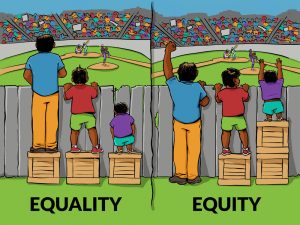 If you want to play
around with this metaphor yourself, check out the
4th Box toolkit. Recently, the people at the Center for Story-Based
Strategy and the Interaction Institute for Social
Change worked with artist Angus Maguire to recreate the
fence image, producing the beautiful version to the right. It went viral,
and they noticed a lot of people remixing the image to expand on the
concepts. So they collaborated with Maguire again to create an adaptable
visual toolbox, which makes it easy to create your own image in the “4th
box” as shown below. They’ve been using it to inspire both in-person
and online dialogues.
If you want to play
around with this metaphor yourself, check out the
4th Box toolkit. Recently, the people at the Center for Story-Based
Strategy and the Interaction Institute for Social
Change worked with artist Angus Maguire to recreate the
fence image, producing the beautiful version to the right. It went viral,
and they noticed a lot of people remixing the image to expand on the
concepts. So they collaborated with Maguire again to create an adaptable
visual toolbox, which makes it easy to create your own image in the “4th
box” as shown below. They’ve been using it to inspire both in-person
and online dialogues.
I still see a lot of drawbacks to the core metaphor, however, so I’ve been on the lookout for others. One I’ve heard, which I think works better, references runners on a racetrack. On an oval track, the outer lanes are actually longer than the inner lanes. If everyone started at the same place, some would have to run farther than others. So, naturally, we start runners at different places along the track. Here’s a mock-up of this metaphor, though it assumes that you already know about the different lengths of each lane:
Beyond this, I haven’t had any major breakthroughs, and the idea of life as a “race” isn’t very appealing to me. Fortunately, I was not the only one trying to figure this out. Meyer Memorial Trust and Northwest Health Foundation had similar concerns, so they launched the Equity Illustrated contest, asking Oregonian artists to take up the challenge.
First place winner Salomé Chimuku rejected the simple metaphoric approach all together, noting that “equity isn’t about watching baseball.” Instead she offers a series of cartoon portraits of friends, with quotes from each illustrating a different aspect of equity. The result has the quality of a conversation. Here’s a sample. You can download the whole pdf HERE.
The third place illustration, from Matt Kinshella, is also pretty great. It keeps the simplicity of the fence image, but puts aside the baseball metaphor for a more concrete example — one close to my heart as someone invested in community work.
It may seem that I am reading too much into these images. Certainly they were all created with the best of intentions. But metaphors are important. They help us understand new ideas by referencing things we already know. At the same time, they shape our experience, opening us up to some ideas while closing us off to others. The mental shorthand we use to understand “equity” will affect how we go about fighting for it.
In the spirit of keeping the conversation going, I’ll end with this image from Sam Killermann, which I find pretty amusing, and which you can buy in poster or t-shirt form.
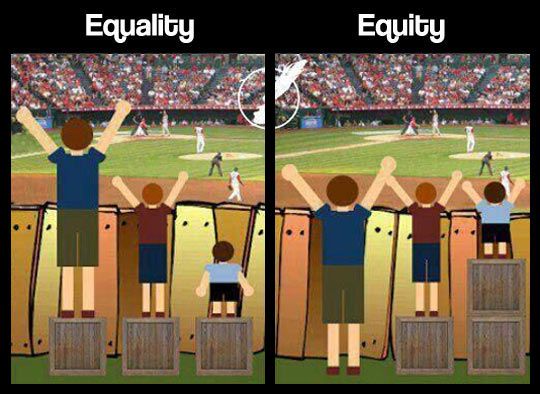
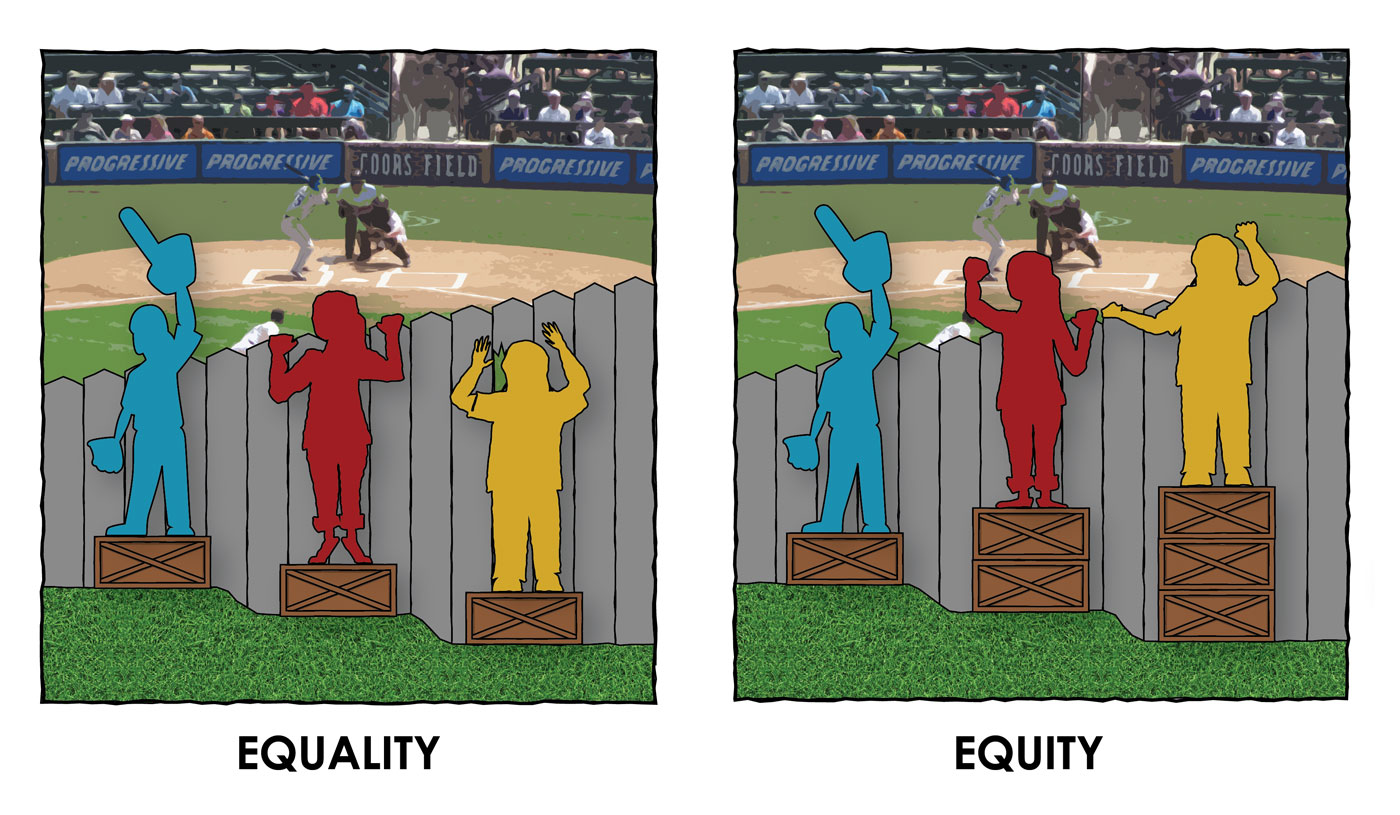
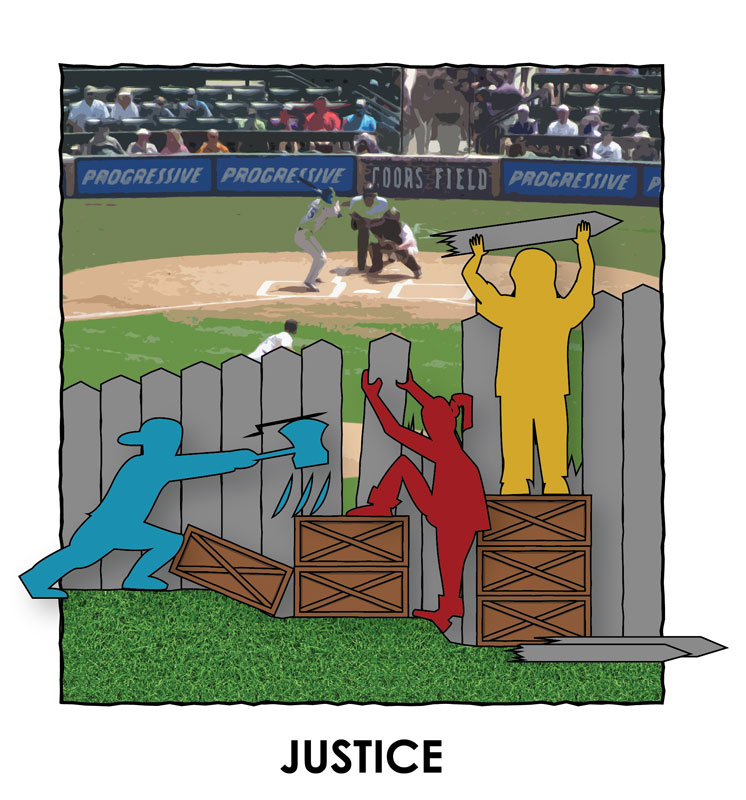
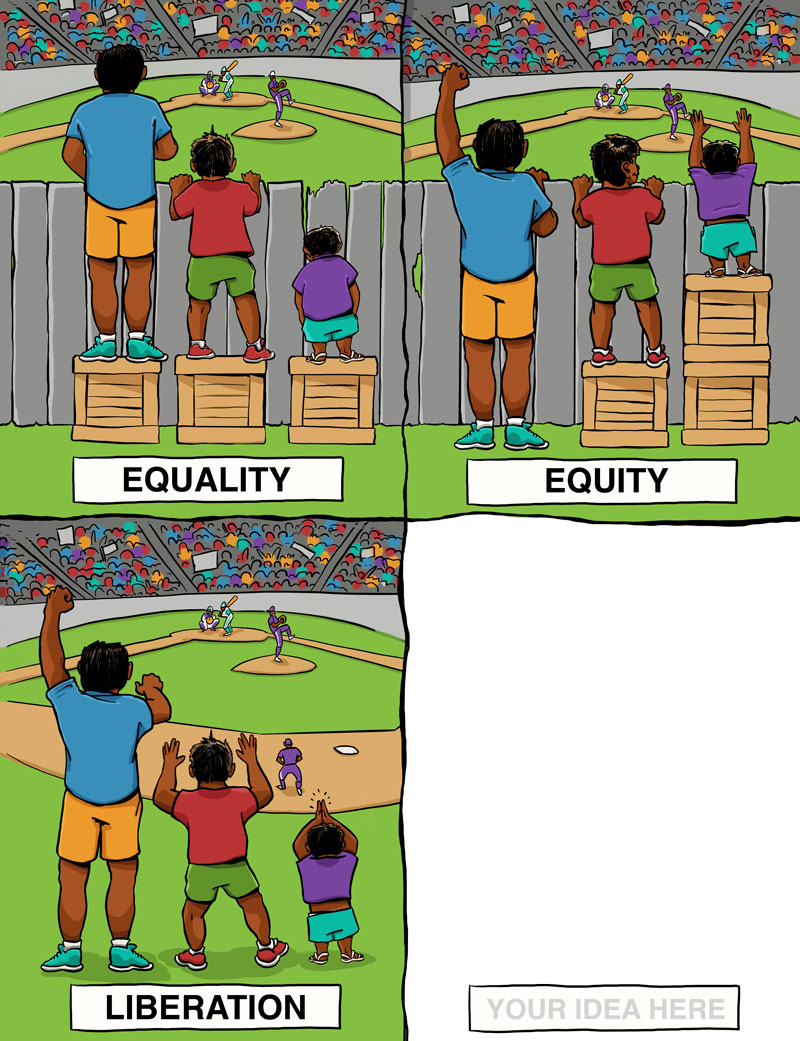
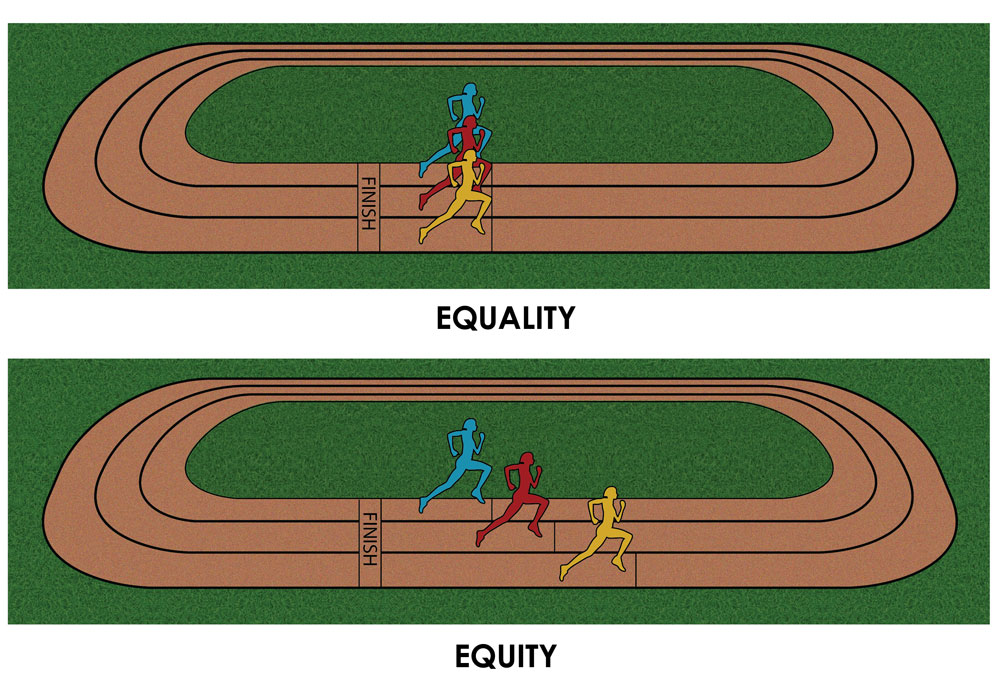
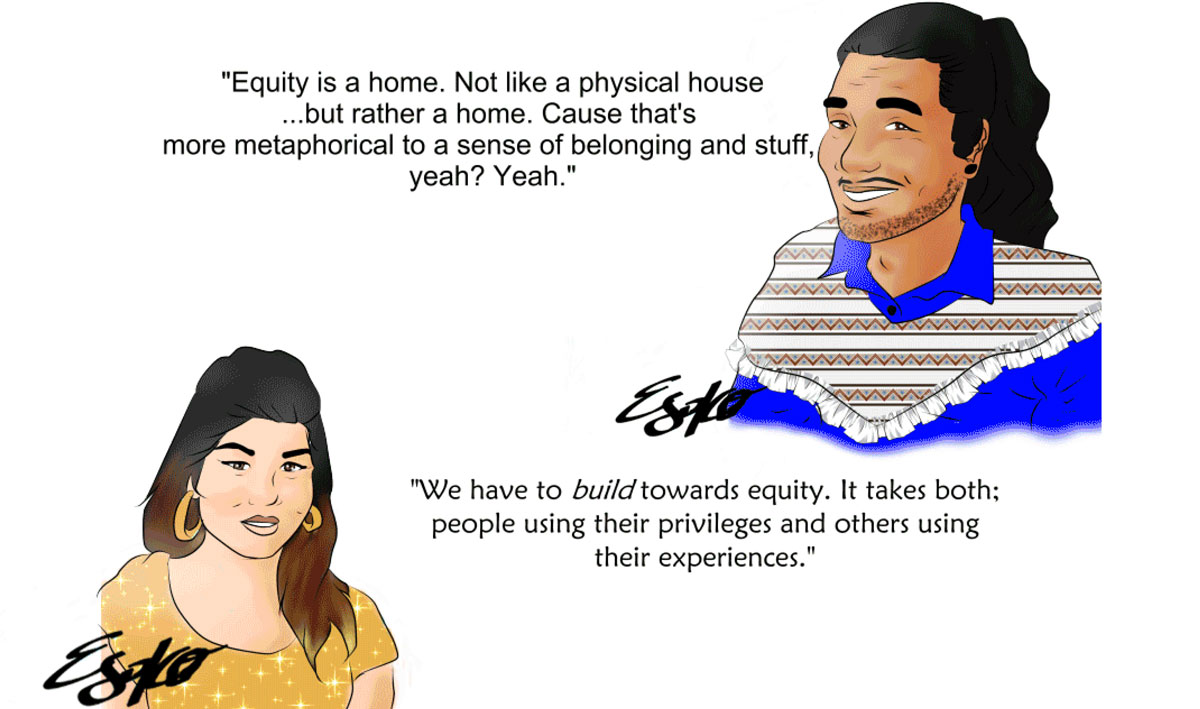
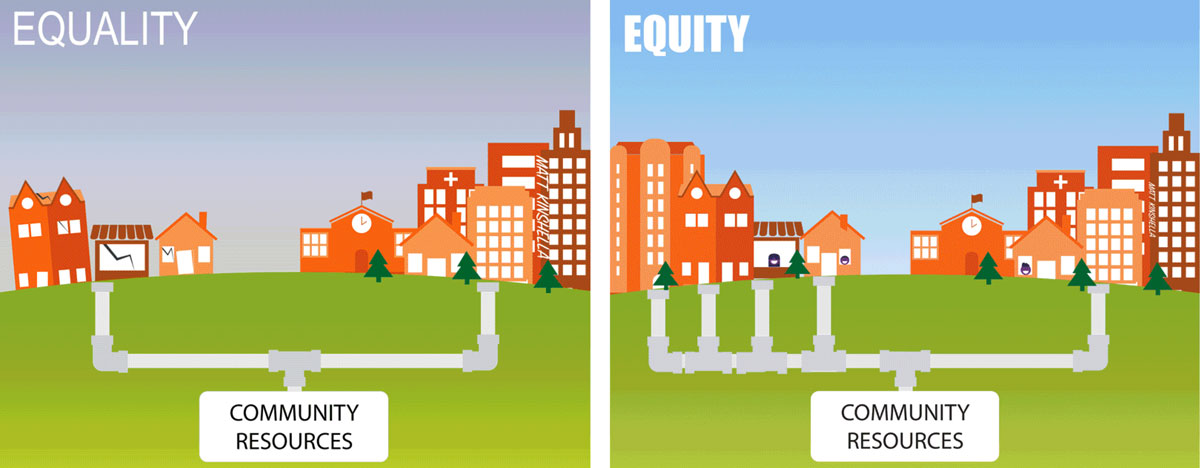
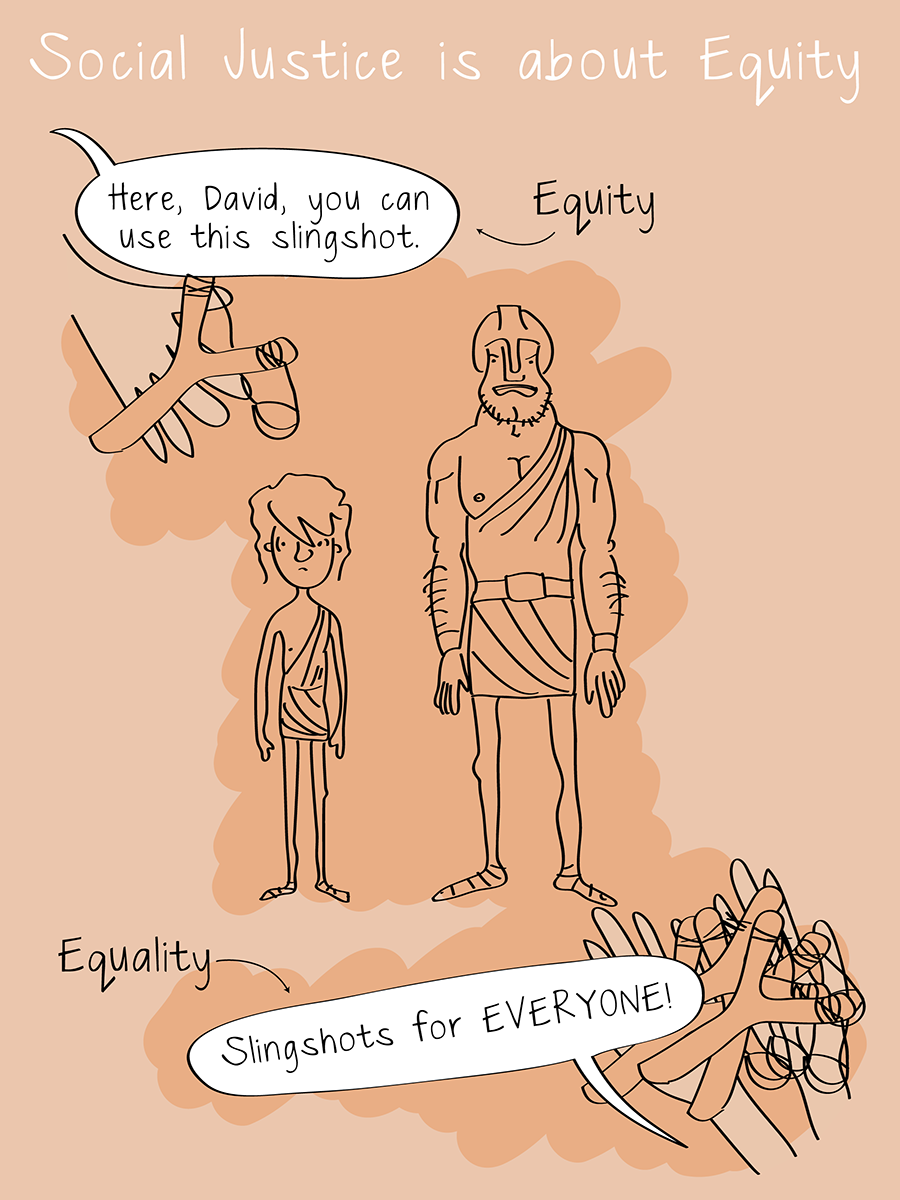
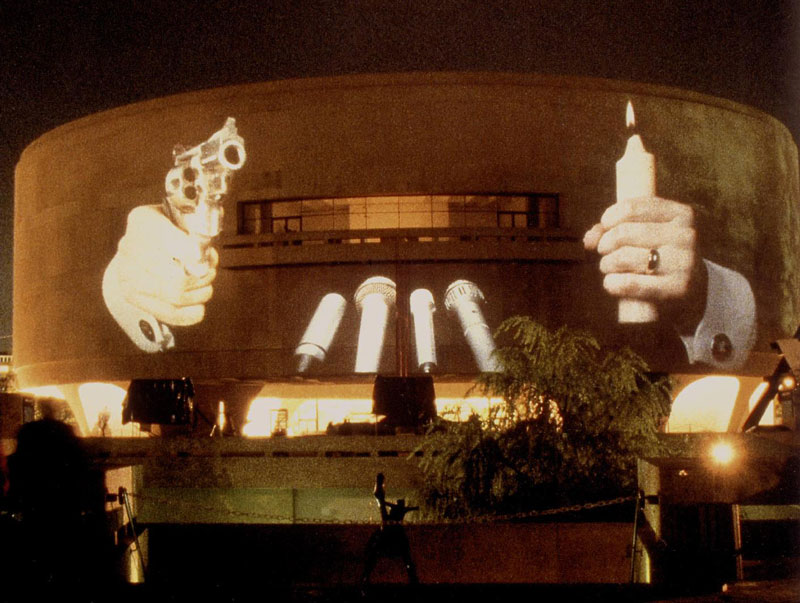

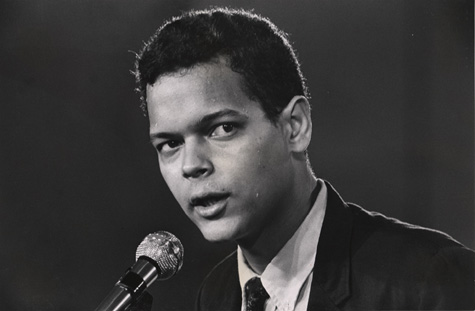
I don’t think you are reading too much into these images. I love the thoughts that went into them & the ideas shared. I have nothing to add at this time, but I think I will be sharing these ideas with my high school
seniors soon.
Absolutely and fantastic!
This kind of thoughtfulness is needed across data visualization, UX, coding and design of big data algorithms…. where I consistently run into paucity of social science background and social justice analysis. My shorthand: ‘We code what we are: we become what we code.”
Outstanding.
please keep me in your loop for future.
dig it
The original comic does, in fact, address this: http://img-9gag-fun.9cache.com/photo/ajAerM1_700b_v2.jpg
Thanks Amanda, I have seen that version, as well as a few others that have a third image addressing more systematic change. I didn’t have time to discuss all the variations. There’s even a site that helps you design your own version! http://madewithangus.com/portfolio/equality-vs-equity/
I’d still argue that the core critique here is valid — that using height as a metaphor for oppression leads to deficit-based interpretations. I think we can do better with our visual metaphors. People of different heights facing the SAME challenges (the same height fence) does not, to me, capture the systemic nature of oppression, which actually benefits some at the expense of others. Not that I’ve found a perfect alternative either…
Thanks for joining the discussion!
I have always disliked the equity metaphor being focused on people watching a central event from ‘outside’. Even if they can all see, they are behind a fence!!! So thank you, all,for creating alternate narratives!
I like the effort to depict infrastructure equity into the equation!! But I would say that another graphic, showing ALL the pipes going to afffluent white communities is the precedent to the following ones of trying to rectify equality or equity….
Thanks, Amanda! I was gonna find my download of that image from a few months ago….
Sadly our culture has lost much of the simplicity of parables, which referred to all of this using simple metaphors or analogies, often animal relations. I wouldn’t be surprised if La Fontaine has a story that’s all about equity and equality. In fact it is just a sign of how we have lost a connecting to the old great chain of beings – we now think so hierarchically, ideologically and abstractly that we struggle to think or visualise about relations of power.
Bump
Shouldn’t they be buying tickets to the game?
YES! The above are basically metaphors for stealing!
This is a valid critique as well. For some people, the image could reinforce the view that people asking for government “handouts” are moochers – trying to see the game for free when everyone else is paying (a view that is flawed and misconceived but nonetheless very popular).
Wanting more alternatives and desiring different options for how we visualize this is exactly why we re-did the original comic and made the graphics available for cut outs and digital re-imagining/making options. Thank you for engaging in the discussion around what else is possible. At the Center for Story-based Strategy we believe in discussing what is possible, what alternative solutions are out there, and how we can help folks engage by giving folks a starting place. Please check out http://www.the4thbox.com/.
Yes! I found that and added it to the article above, very cool. And big shout out to the Center for Story-Based Strategy, I’ve been a fan for years /book-review-reimagining-change/
I don’t think you’re reading too much into the images at all. Thanks for the enlightening post and revised graphics.
I think the original comic is the most powerful. In my opinion, the fence symbolises the barriers to entry into a workforce, it can be placed a dollar amount on. One dollar equals one dollar. However your starting point in life and the advantage you get out of lets say better schools and the environmental examples of your upbringing lets you grow as a person. Therefore the smaller child that symbolises the disadvantaged communities did not yet grow into the fully developed legally capable human on the left. Thus they need some extra help to grow into the person on the left.
Back when I was in school, teenagers being teenagers, were complaining that something wasn’t fair. That led to a thought provoking discussion on what is really fair and the conclusion was that fair was not everyone getting the same thing, it was everyone getting what they needed. In the original design, every person got what they needed to see over the fence. You said “… if we return to the school funding example, this image implies that students in low-income Communities of Color and other marginalized communities need more resources in their schools because they are inherently less academically capable.” I disagree. More funding is needed because students in low-income families tend to start out with less and need the opportunity to be allowed to catch up. It doesn’t mean they are less capable, but when a child in a more prosperous family starts out with a library of 100 books in their bedroom and parents that have the time to read 10 bedtime stories every night, that is going to start that child off on the path not to need an extra crate to see the game with little extra effort on the part of the child, especially in the early elementary ages. A child in a low-income family that has no books at home and parents that are working 15 hours a day to try to make ends meet is not afforded the same opportunity to get on the path to see over the fence without help.
To use another sports analogy to address the size concern, a child born to tall parents, who also grew tall, will have an advantage on the basketball court because of his or her size. Their size is not something they earned, there is nothing they did to influence their size. Their size was just luck of the draw as to where they were born. That advantage, however, will fade fast if that child doesn’t do something with that gift. All the size in the world will not make you a star player if you never practice. You also need the support of those around you to get you to practice, see that you have shoes to wear to practice, eat healthy foods to maintain your stamina to practice. You also cannot become star without the help of your team and that is the part that is missing when we talk about low income schools. The focus is on the school and what the school can do to fix this situation and very little attention to the community as a whole, the parents, the neighbors, the business people, everyone, to promote an atmosphere that values education, learning and achieving? Let us not simply focus on what the school can do for you, let us focus on changing atmosphere as a whole in the low income communities because until we do that, the opportunity gap will never close.
One could look at the short person in that drawing and conclude that they got the short end of the stick, which is neither hear nor there, it’s what they did with that stick (or crates) that will make the difference.
The author wasn’t saying lower income students actually were less capable. He was saying he didn’t like that the image implied that. Specifically because they are NOT less capable.
Amy Johnson – I love your analogies. I love that a group of teenagers discussed this and may take it with them through life. I fully agree you may have all the tools and may choose not to use them. But I mostly agree with the comment that a community needs to be a part of the solution however the community may choose to address it. Guidance would be phenomenal for that community.
A metaphor that uses the race track but goes beyond the inner a d putter lanes disadvantage can be found here: https://youtu.be/vX_Vzl-r8NY
Wow…That’s impressive. That takes the race track metaphor about as far as it could possibly go!
What I dislike about the majority of the arguments here is the “preaching to the choir ” part of it. Of course, anyone who is open to the idea will understand this picture and look for the nuances of it . But what I found most appealing is that is a simple picture/concept for people WHO HAVE NEVER THOUGHT THIS WAY BEFORE. You must first get the ignorant to have a little crack in their thinking. Of course these pictures are simplistic. But to people who have never thought this way before, they are mind blowing . The nuances you are discussing are for people who have already crossed to your side of the river .
I totally agree with you Jenny. For people who have already thouhgt through equity vs equality, the thinking is ahead, but if it is the first time, it makes people start thinknig about the nuances.
Fair enough. This image has been useful to many as a first step into a big conversation. But what if we found a different, simple image, that was closer to what we wanted to communicate?
Educating is sharing knowledge. Sharing is caring. When you share you have more. They will come over. You have to expose them to the ideas and have faith. Even God doesn’t have 100% following him, he does although have faith in the ones who do. Have faith in sharing the idea.
You’ve totally been misinformed about the point of this graphic. It isn’t about low socioeconomic status. It’s about students who were born with disabilities. If you are dyslexic, you need more support to learn. If you are born with autism, you need more resources to learn. I’m a special education teacher and have had dozens of trainings on this graphic. It was made for special education, not race.
Hi Kerry,
It wasn’t actually created for special ed, but I can see why it would be particularly useful in that field. You can read about what it was made for here: https://medium.com/@CRA1G/the-evolution-of-an-accidental-meme-ddc4e139e0e4#.yy8zi6s0o
Even in special ed, however, a critique of this metaphor could be useful for discussion. Sometimes special ed is about giving individuals what they need individually to succeed, but we also have to turn our attention away from individuals to the larger education systems that only work for some people. A critique of this metaphor could encourage us to move towards things like Universal Design for Learning. Here’s a good cartoon that captures this idea, in my mind: http://simplyaccessible.com/wordpress/wp-content/uploads/2016/03/ramp-children-illustration-773×1024.png
I would argue it certainly was never made for race, but whether it was made for SpEd or socioeconomic disadvantages is neither here nor there. The point is to ensure that all kids receive the resources necessary to achieve their potential.
It is of interest to me that the Justice version has everyone removing the fence …. from in front of themselves. They’re not helping each other in any way.
Hey, Paul. Interesting post. The original graphic wasn’t meant to imply only inherent differences or “deficit thinking.” Their heights are symbolic of any differences among individuals, whether innate or imposed, and the crates are symbolic of any kind of support or investment, including external, financial, emotional, developmental, or otherwise. Also, the fence isn’t merely “oppression,” as you call it…it could be any form of barrier to one’s full self-realization and perceived value in society. It could be something as malignant as systemic oppression, or it could be something more subtle and personal, like introversion. I’m sorry if anyone interpreted the image narrowly…it wasn’t my intent.
HI Craig,
Thanks for commenting, and for the insights into your thinking about the image. I enjoyed reading your article about the history of it. The truth is that I was probably responding most to how the image is used in the field of education and in social justice activism, which is a more limited use than you suggest.
Clearly many people have found your image very useful for parsing apart a difficult distinction. You’ve helped start a huge conversation that really wasn’t happening before, at least on this scale. So thank you, and I offer this article in the spirit of continuing that discussion and finding even more innovative ways to visualize difficult concepts.
Awesome…great to hear. When thinking about the image initially, I needed to use a difference between people that was easy to portray and instantly (if not universally) recognizable, so height seemed like a good choice. Unfortunately, we’ll never be able to fully separate individuals’ situations from their personal characteristics in the eyes of those who want to use characteristics to justify situations. Those two — situations and characteristics — are confounded at the level of the individual, and “blame” can always be leveled by those who want to think in such terms. The best thing we can do, I think, is to educate people about their perceptions and try to inoculate them against prejudicial thinking. So, to that end, I appreciate your post here and hope it continues to help convey and evolve our appreciation of these issues.
Universal Income?
Good article! I really like the reframe.
Here is another framework which could be retooled to address these concepts:
https://www.google.com/amp/s/www.buzzfeed.com/amphtml/nathanwpyle/this-teacher-taught-his-class-a-powerful-lesson-about-privil
I searched for the original source, but couldn’t find it. Unfortunately, buzzfeed isn’t keen on citation.
Good thought provoking article. It reminds me of the statement often used in other circles i.e. it is not over until it is over! There’s always another angle from which to view anything besides yours. This is one of the basic premises of the notions of tolerance and accommodation; and it is always good to keep it in mind. I note though the comment by Kerry that the context and audience of the initial graphic should be considered in further reviews. Context is always important for good understanding.
I love the critical lens you are bringing to our use of these images. In my teaching I like to emphasize that the height differential is metaphoric and that we shouldn’t interpret it to be a within person characteristic. But I love your additional suggestions!
Paul, thanks for posting this! I think it’s a really valuable exercise and I’m hopeful a new, better graphic will eventually emerge and go viral as a result of analysis & dialogue like this.
One thing I’ve struggled with is the purpose of the graphic itself and whether we need to rethink it: clarifying the difference between equity & equality according to a particular politicized bifurcation of the two driven by academics in an attempt to distinguish the what from the how of social justice work. We all want equal outcomes yet the word “equity” has been subbed in for “equality” to specifically mean non-equality of process, not non-equality of outcomes. Is it really worth it to work so hard to clearly visually define this artificial and constructed difference? It’s the ideas behind the two that are important, not the words.
The attempt at distinction is itself an effort to reject the hypothesis that equal distribution of resources across lines of advantage and disadvantage will give everyone equal “access” or “opportunity”, eventually rectifying the race/gender/ability outcome gaps. Most liberals completely reject this theory of change opting instead for one that uses equity in the “how” — distributing resources proportionally in accordance with disadvantage. To use the word “equity” as shorthand for this liberal theory of change which we support and “equality” as shorthand for a presumably ineffective and more conservative theory of change which we do not seems like an artificial appropriation of these similar concepts to suit liberal ends.
What if we focused more clearly on the difference between outcomes & the “how” of getting to them instead of attempting to use a single word to capture both — how would that change the words we use? Or what if we tried to make the language itself more accessible, using words like “same” and “fair”?
We have started trying out the term “outcome gaps” as public-facing shorthand for “racial inequity” as we’ve started building out a racial equity communications toolkit. I’m hoping to test this language to some extent and would love to someday get to a better shorthand for the equity v. equality issue — it seems so academic and artificial and unlikely to ever translate into common usage even if we do somehow get the metaphor right.
Thanks again!
Fascinating analysis, thank you! Good points all around, and I’m excited to see what you come up with in your toolkit.
I believe the problem lies in where to draw the line. The graphic makes its point very clear but its in reference to a baseball game. What about necessities? consider this. individual A has a high paying salary and affords their family plenty of food. individual B does not and their family lives largely on government aid. So should the government provider all the same food to individual B that A affords? of course not right? but then where is the line drawn. Who is deciding what is enough? the world is a lot bigger than 3 people wide and will take a lot more than crates to fix this mess
Hi, Ike. You raise an important point. What I was trying to represent by the baseball game isn’t just that — the game is symbolic of any opportunity that individuals may want to pursue, from education to healthcare to employment to housing to, yes, even entertainment. See the game in the background merely as “something individuals want access to” rather than anything specific. And yes, the debate over how much should the government do will be ongoing — there’s no solving that one. But if you take the boxes not merely as government support, but as representing the totality of society’s support for an individual (including family, private, industry, institutional, community, and governmental supports), then I hope the graphic is a little more generalizable. Thanks for raising these issues.
Really appreciate this piece and the related commentary. As this is a group interested in these matters, wanted to add a minor point on the 3rd version (housing) by Matt Kinshella. His city in disrepair is shown through ‘broken windows’. Critical criminologists have worked to discredit the broken windows theory – in short, the focus on minor crimes actually brings more unwanted police attention to historically targeted populations. Here is a link to a popular piece to give a bit more background: http://bit.ly/2f2nAZB
Oops, meant this link (though the earlier link is useful to help debunk it w/some NY data): http://bit.ly/1hG265C
That two of the primary examples illustrate mere entertainment or competition is telling.
For the “put your idea here” I would insert “interdependence” and have the individuals working together. In all of the existing images there is no interaction among the individuals. This unexamined individualism is the basis for misplaced thinking on “equality” to begin with, so if you want to challenge that, challenge the ideology of individualism.
The problem with your “justice” and “liberation” graphics is that they completely ignore the fact that the people inside the ballpark worked for their mean to afford tickets and be able to pay the players to provide them their entertainment at the game.
People standing on boxes to see over a fence is a dubious approach to viewing a game for which they had not paid admission. Tearing down the fence is vandalism and destruction of someone else’s property. Removing the fence altogether fundamentally changes the game being played inside the ballpark and demonstrates that once again, the cause is all about the people outside the fence and their whims, desires, and feelings of being left out, and no consideration for those who built the fence necessary for the playing of the game, or protecting the investment they made in the ballfields, the club, the players, etc.
WOW a completely different perspective. Lots of valid points being made. It is good to see all sides to the opinions. I agree sometimes you are dont realize what you are encouraging… this could be an example of exactly that
You know what would bring clarity and resolution to this conversation?
How about inviting the people you are talking about into the conversation.
People of higher socio-economic status or people of noncolor are always speaking
for those who encounter the iniquities of the world’s system. Ask them, they are capable
of giving a perspective on the equity vs. equality graphics. Something to ponder…..
(The link below: Francheska will “break it down” about being a good ally). Enjoy! 🙂 God bless!
https://youtu.be/_dg86g-QlM0